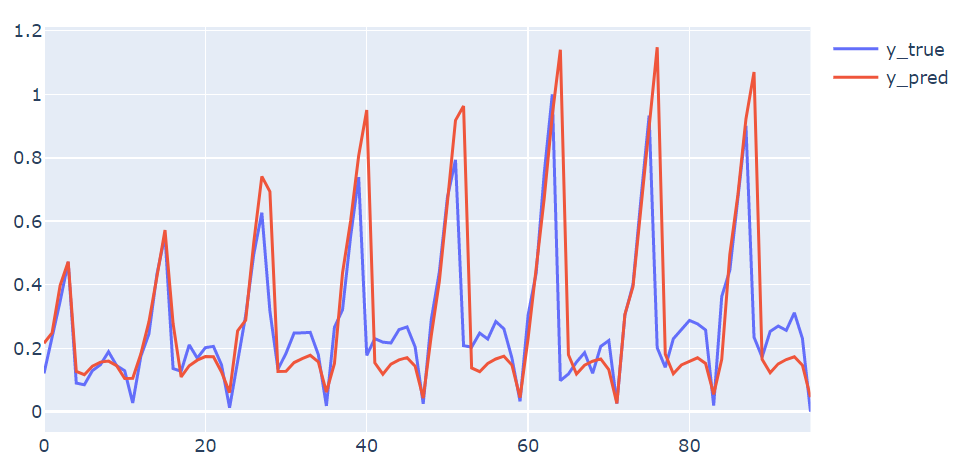
pytorch LSTM 时间序列预测
pytorch LSTM 时间序列预测
·
pytorch LSTM 时间序列预测
- 更新 (2022-11-25):
- 关于有朋友提到因
torchkeras版本问题报错,本文使用的是1.5版本,安装方式可在终端执行pip install torchkeras==1.5 - 关于新版
torchkeras接口有较大改动,有兴趣的朋友想了解具体使用方法可参考原始仓库:https://github.com/lyhue1991/torchkeras
- 关于有朋友提到因
#%%
import pandas as pd
import numpy as np
import torch
from torch import nn
from torch.nn import functional as F
from torch.utils.data import TensorDataset, DataLoader
import torchkeras
from plotly import graph_objects as go
from sklearn.preprocessing import MinMaxScaler
#%%
# 导入数据
# 数据下载:https://www.kaggle.com/kankanashukla/champagne-data
# 下载地址2:https://gitee.com/jejune/Datasets/blob/master/champagne.csv
df = pd.read_csv('champagne.csv', index_col=0)
df.head()
Month Sales
1964-01 2815
1964-02 2672
1964-03 2755
1964-04 2721
1964-05 2946
#%%
# 数据预览
fig = go.Figure()
fig.add_trace(go.Scatter(x=df.index, y=df['Sales'], name='Sales'))
fig.show()

#%%
# 数据处理
# 归一化 [0, 1]
scaler = MinMaxScaler()
predict_field = 'Scaler'
df[predict_field] = scaler.fit_transform(df['Sales'].values.reshape(-1, 1))
df.head()
Month Sales Scaler
1964-01 2815 0.112133
1964-02 2672 0.100696
1964-03 2755 0.107334
1964-04 2721 0.104615
1964-05 2946 0.122611
#%%
def create_dataset(data:list, time_step: int):
arr_x, arr_y = [], []
for i in range(len(data) - time_step - 1):
x = data[i: i + time_step]
y = data[i + time_step]
arr_x.append(x)
arr_y.append(y)
return np.array(arr_x), np.array(arr_y)
time_step = 8
X, Y = create_dataset(df[predict_field].values, time_step)
#%%
# cuda
device = torch.device("cuda:0" if torch.cuda.is_available() else "cpu")
# 转化成 tensor->(batch_size, seq_len, feature_size)
X = torch.tensor(X.reshape(-1, time_step, 1), dtype=torch.float).to(device)
Y = torch.tensor(Y.reshape(-1, 1, 1), dtype=torch.float).to(device)
print('Total datasets: ', X.shape, '-->', Y.shape)
# 划分数据
split_ratio = 0.8
len_train = int(X.shape[0] * split_ratio)
X_train, Y_train = X[:len_train, :, :], Y[:len_train, :, :]
print('Train datasets: ', X_train.shape, '-->', Y_train.shape)
Total datasets: torch.Size([96, 8, 1]) --> torch.Size([96, 1, 1])
Train datasets: torch.Size([76, 8, 1]) --> torch.Size([76, 1, 1])
#%%
# 构建迭代器
batch_size = 10
ds = TensorDataset(X, Y)
dl = DataLoader(ds, batch_size=batch_size, num_workers=0)
ds_train = TensorDataset(X_train, Y_train)
dl_train = DataLoader(ds_train, batch_size=batch_size, num_workers=0)
# 查看第一个batch
x, y = next(iter(dl_train))
print(x.shape)
print(y.shape)
torch.Size([10, 8, 1])
torch.Size([10, 1, 1])
#%%
# 定义模型
class Net(nn.Module):
def __init__(self):
super(Net, self).__init__()
self.lstm = nn.LSTM(input_size=1, hidden_size=6, num_layers=3, batch_first=True)
self.fc = nn.Linear(in_features=6, out_features=1)
def forward(self, x):
# x is input, size (batch_size, seq_len, input_size)
x, _ = self.lstm(x)
# x is output, size (batch_size, seq_len, hidden_size)
x = x[:, -1, :]
x = self.fc(x)
x = x.view(-1, 1, 1)
return x
#%%
# torchkeras API 训练方式
model = torchkeras.Model(Net())
model.summary(input_shape=(time_step, 1))
model.compile(loss_func=F.mse_loss, optimizer=torch.optim.Adam(model.parameters(), lr=1e-2), device=device)
dfhistory = model.fit(epochs=50, dl_train=dl_train, log_step_freq=20)
----------------------------------------------------------------
Layer (type) Output Shape Param #
================================================================
LSTM-1 [-1, 8, 6] 888
Linear-2 [-1, 1] 7
================================================================
Total params: 895
Trainable params: 895
Non-trainable params: 0
----------------------------------------------------------------
Input size (MB): 0.000031
Forward/backward pass size (MB): 0.000374
Params size (MB): 0.003414
Estimated Total Size (MB): 0.003819
----------------------------------------------------------------
Start Training ...
================================================================================2022-03-28 12:21:58
+-------+-------+
| epoch | loss |
+-------+-------+
| 1 | 0.045 |
+-------+-------+
================================================================================2022-03-28 12:21:59
+-------+-------+
| epoch | loss |
+-------+-------+
| 2 | 0.054 |
+-------+-------+
...
+-------+-------+
| epoch | loss |
+-------+-------+
| 50 | 0.003 |
+-------+-------+
================================================================================2022-03-28 12:22:00
Finished Training...
#%%
# 模型评估
fig = go.Figure()
fig.add_trace(go.Scatter(x=dfhistory.index, y=dfhistory['loss'], name='loss'))
fig.show()

#%%
# 预测验证预览
y_true = Y.cpu().numpy().squeeze()
y_pred = model.predict(dl).detach().cpu().numpy().squeeze()
fig = go.Figure()
fig.add_trace(go.Scatter(y=y_true, name='y_true'))
fig.add_trace(go.Scatter(y=y_pred, name='y_pred'))
fig.show()

#%%
# 自定义训练方式
model = Net().to(device)
loss_function = nn.MSELoss()
optimizer = torch.optim.Adam(model.parameters(), lr=1e-2)
def train_step(model,features, labels):
# 正向传播求损失
predictions = model.forward(features)
loss = loss_function(predictions, labels)
# 反向传播求梯度
loss.backward()
# 参数更新
optimizer.step()
optimizer.zero_grad()
return loss.item()
# 测试一个batch
features, labels = next(iter(dl_train))
loss = train_step(model, features, labels)
loss
0.016526855528354645
#%%
# 训练模型
def train_model(model, epochs):
for epoch in range(1, epochs+1):
list_loss = []
for features, labels in dl_train:
lossi = train_step(model,features, labels)
list_loss.append(lossi)
loss = np.mean(list_loss)
if epoch % 10 == 0:
print('epoch={} | loss={} '.format(epoch,loss))
train_model(model, 50)
epoch=10 | loss=0.047142161638475955
epoch=20 | loss=0.03120349021628499
epoch=30 | loss=0.009641124575864524
epoch=40 | loss=0.002635095050209202
epoch=50 | loss=0.0018647939796210267
#%%
# 预测验证预览
y_pred = model.forward(X).detach().cpu().numpy().squeeze()
fig = go.Figure()
fig.add_trace(go.Scatter(y=y_true, name='y_true'))
fig.add_trace(go.Scatter(y=y_pred, name='y_pred'))
fig.show()

更多推荐
 已为社区贡献1条内容
已为社区贡献1条内容









所有评论(0)